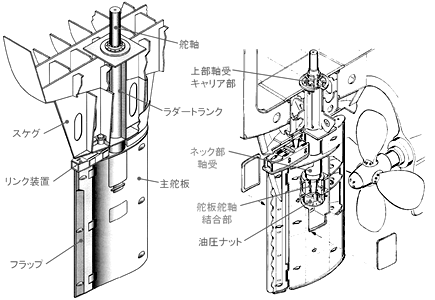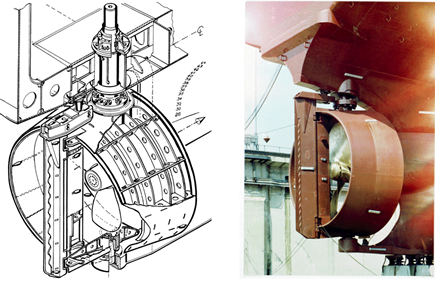
Nakashima Propeller is a general manufacturer of marine propellers and other propulsion equipment. Nakashima Propeller provides reliable propulsion equipment for vessels navigating the world’s oceans and seas.
- HOME
- Product lineups
- Other marine equipment Rudders
Other marine equipment Rudders

Rudders are greatly associated with vessel maneuverability. The required balance between directional stability and course stability varies according to the purpose of the vessel and route. Nakashima Propeller offers a wide range of rudders with optimum balance for the intended purposes.
In technical cooperation with Becker Marine Systems (BMS) in Germany, Nakashima Propeller manufactures and offers an extensive range of rudders including flap rudders. The rudders provided by Nakashima feature a rudder trunk with a unique structure. The carrier part, seal part, and neck bearing are built to form an integrated rudder trunk structure, which is greatly simplified compared to conventional rudders, significantly cutting the necessary man-hours for installation. The carrier part has self-regulatory spherical roller bearings so that uneven wear on the neck bearing can also be reduced.
Flap rudder

Flap rudders are synonymous with Becker rudders and are one of Nakashima Propeller’s main products. Flap rudders can be used on all types of vessels, from small-size to large-size vessels. Nakashima Propeller has already sold flap rudders for use on 2,800 vessels. Because of the effects of the flap, this rudder can generate over twice as much lift compared to regular rudders with the same area. The use of the rudder dramatically improves maneuverability of vessels. A link structure is used so that the flap is directed at 90 degrees relative to the vessel’s back and forth direction when the rudder angle of the main rudder blade is 45 degrees. Configuration of a rudder angle of 60 degrees is also possible. The KSR rudder trunk structure is used for medium to large-size hanging rudders.
Rudders with the KSR rudder trunk structure
This type of rudder competes with mariner rudders for use in medium to large-size vessels. The bending moment of the rudder stock is reduced by locating the neck bearing of the rudder trunk near the center of rudder pressure inside the rudder blade, which enables a rudder stock of smaller diameter and thinner rudder blade. Since there is no rudder horn, mechanical processing for centering is unnecessary. As a result, significantly fewer man-hours are required for installing the entire rudder system and the weight is greatly reduced (over 30 %). This type of rudder provides a more effective rudder area as compared to rudders with a rudder horn structure. It also offers better steering because the entire rudder is movable. The rudder trunk structure is used in medium to large-size hanging rudders (ordinary rudders, flap rudders, and twist rudders).

Ordinary rudders (CR)
This type of rudder has an extremely simplified structure using a common rudder trunk with regular flap rudders. In the case of medium-sized or larger hanging rudders, a hub is installed on the upper end of the rudder blade, connected to the rudder stock by taper joint, and fixed using a hydraulic nut. A structure where the rudder trunk is housed in the rudder blade (KSR structure) is used when there are restrictions in the design conditions such as vessel speed.

Twisted rudders
This type of rudder has a KSR-type trunk structure where the leading edge of the rudder is twisted horizontally on the top and bottom of the section that is an extension of the center of the propeller shaft. The optimum cross-section shape is also used. This type of rudder has a great fuel saving effect for large-size high-speed vessels and efficiency can be improved by approximately 2%. Even higher efficiency can be achieved by combining it with other fuel-saving features such as adding a valve or flap. In South Korea, this type of rudder is recognized as a standard rudder for large-size high-speed container carriers. In Japan, Mitsubishi Heavy Industries’ shipbuilding yard in Nagasaki Prefecture received its first order for this type of rudder for four large-size roll-on/roll-off container carriers in 2008. The products are imported from BMS.

Kort nozzles and nozzle rudders
Other than the above, Nakashima Propeller manufactures and sells fixed Kort nozzles and nozzle rudders (with a fixed fin/flap).
Advantages
- Higher bollard pull
- Higher propulsion efficiency
- Better maneuverability
- Reduced vibrations
- Safety in the case of damage to the propeller
- Better fuel efficiency
Most suitable for the following types of vessels
- Tugboats
- Fishing vessels
- Research vessels
- Supply vessels and special ships
- Dredger and cable laying vessels, etc.








